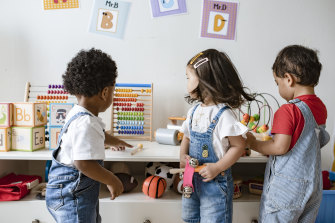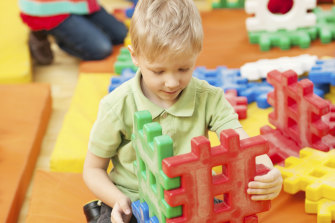
Lego’s return to gender-neutral toys is good news for all kids
When children observe different toys and tasks for different groups, they can learn stereotypes and prejudices, such as viewing shopping as an activity for girls and “fixing things” and using tools as activities for boys. This can reinforce rigid binary views of gender.
Such stereotypes and prejudices can be carried throughout life, making early childhood critical for setting the foundations for lifelong attitudes.

Early childhood is critical for setting the foundations for lifelong attitudes.Credit:iStock
The Lego research found parents were more likely to encourage their daughters to engage in activities that are more cognitive, artistic and performative (dressing up, dancing, colouring, singing and arts and crafts), and more likely to encourage their sons to engage more in digital activities, science and building.
Beliefs and expectations about what types of toys and play are appropriate for girls and boys can compound over time.
Some studies show that play with some stereotypical girls’ toys, such as princess toys, is associated with more female gender-stereotypical behaviour among children.
Not engaging in play with construction toys may mean girls miss opportunities to develop spatial skills and mechanical reasoning skills necessary for careers in science, technology, engineering and mathematics: fields in which women continue to be under-represented.

Toys are only one way in which children learn gender roles and stereotypes.Credit:AFR
Toys are only one way in which children learn gender roles and stereotypes: they also learn from who they see around them in their daily lives, from the books they read and the TV shows they watch.
Parents and caregivers have a key role in encouraging children of all genders to engage with a wide range of activities and toys.
But since the 1970s, toys have become increasingly and rigidly demarcated along binary gender lines.
Loading
Even Lego’s own marketing history demonstrates this: compare the gender-neutral advertisements from the early 1980s to more recent gender-specific marketing with pink bricks and heart shapes.
The prevention of potentially harmful gender attitudes and stereotypes in childhood – before they become entrenched – is a key element in moves to achieve gender equity and to support health and wellbeing throughout life.
Efforts to reduce the gendered nature of toys and their marketing is one step we can take to give all children more equitable options for how they see themselves, the world, and their future.
Naomi Priest is a professor at the ANU Centre for Social Research and Methods, Australian National University. Tania King is a research fellow at The University of Melbourne.
This article is republished from The Conversation.
Stay connected with us on social media platform for instant update click here to join our Twitter, & Facebook
We are now on Telegram. Click here to join our channel (@TechiUpdate) and stay updated with the latest Technology headlines.
For all the latest LifeStyle News Click Here
For the latest news and updates, follow us on Google News.

